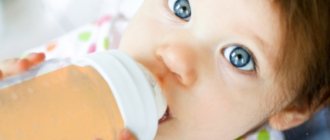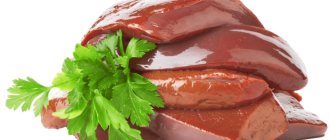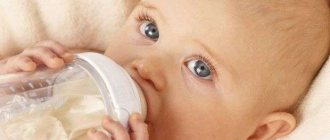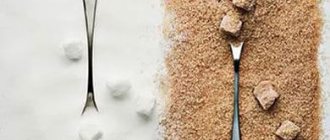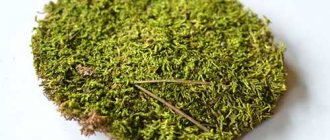Often, a pacifier becomes the most necessary thing for a baby. It helps to overcome gas, speed up the process of falling asleep, distract from unpleasant sensations and improve your mood. But over time, attachment to the accessory develops and very rarely the baby voluntarily turns away from the pacifier. Recommendations from pediatricians and child psychologists will tell young parents how to wean their child off the pacifier without harming his psyche.
Does a newborn need a pacifier?
The newborn has a highly developed sucking reflex. Even while in the mother's belly, the baby can suck its fingers. With the help of sucking, the child calms down and more easily experiences the stresses of a new, unknown world. By the first year of life, the sucking reflex gradually fades away. Most pediatricians, both Russian and foreign, advise giving a pacifier to a newborn. But so that the juice does not cause harm, it should be used correctly.
Baby with pacifier
Advantages and disadvantages of pacifiers
The sucking reflex is one of the most essential innate skills a baby needs. With natural feeding, the need for sucking is almost always satisfied. There is no need to force a pacifier into a child's mouth if he doesn't like it and tries to spit it out. Or, if there is minor crying, offer the baby to calm down with the help of a pacifier.
It's another matter if the child is bottle-fed. Then the sucking reflex is not completely satisfied and a pacifier comes to the rescue. Like any subject, it has its pros and cons.
Advantages:
- The baby quickly calms down. In this case, the pacifier is an indispensable assistant for the mother. It relaxes the child and helps him fall asleep.
- In public places, it distracts the baby from unpleasant sounds. During vaccination, the child tolerates the injection more easily.
- It is better to suck a pacifier than to put your fingers in your mouth or your clothes or diaper.
- When flying, it reduces the risk of ear congestion. Protects against pressure surges.
- Some protection against sudden death syndrome.
Many children can easily do without a pacifier, so you should not accustom your baby to a pacifier from the first days of life, no matter how good its advantages are.
Speech therapists and dentists believe that the pacifier has significant disadvantages:
- the bite is formed incorrectly;
- possible diseases of the oral cavity;
- the baby cannot communicate enough with other children;
- cognitive development occurs with a delay;
- The baby starts speaking late and distorts hissing sounds.
Therefore, the sooner the child parts with the pacifier, the better. And how to wean off the pacifier and when, parents will be advised by specialist recommendations.
Benefits of pacifiers for babies
Arguments in favor of a pacifier:
- The pacifier calms the baby if he is teething or has a fever
- You can calm a crying baby with a pacifier during a walk or in a clinic
- A hungry baby will also calm down for a while if he is given a pacifier. At this time, the mother will be able to prepare the baby's formula.
- Scientists say pacifier reduces risk of sudden infant death during sleep
- With the help of a pacifier, the child quickly and calmly falls asleep
At what age should you wean off the pacifier?
Experts recommend looking for something to replace the pacifier so that the child quickly forgets about it at about 12 months.
Don't hesitate to look for a good alternative if:
- the baby does not let go of the pacifier from his mouth around the clock;
- if the child begins to become hysterical as soon as the pacifier disappears from sight;
- the child does not want to communicate with peers or parents;
- a disease of the speech apparatus and hearing was diagnosed;
- the child has reached 3 years of age.
Harm to a baby from pacifiers
Arguments against pacifiers:
- The pacifier can harm breastfeeding. The more often and longer the baby suckles, the more milk is produced. A pacifier can significantly reduce the time it takes to attach to the breast, which means there will be less milk
- Also, the pacifier can ruin the formation of the bite, as orthodontists say. When sucking the breast, the bite is not disturbed, this has been proven by scientists
- The pacifier is a source of inflammatory diseases of the oral cavity (for example, stomatitis), as well as ear inflammation (otitis media). Care must be taken to maintain pacifier hygiene
- Psychologists say that with the help of crying, a child gets rid of the negative emotions that overwhelm him. If you do not give these emotions an outlet, that is, constantly soothe the child with a pacifier, serious psychological problems may arise.
- Weaning off the pacifier can be very painful for both the baby and the mother.
There are opinions for and against pacifiers
Does a newborn need a pacifier?
There are many pros and cons regarding whether a newborn needs a pacifier, and whether it is possible to do without it. First of all, it is created in order to fully satisfy the baby's sucking reflex, which for newborns is not only a way of obtaining food, but also a good sedative. After all, nature intended this so that the mother would put the baby to the breast every time he shows concern, and he would not remain hungry. Of course, those children whose sucking reflex is fully satisfied (for example, those who are breastfed on demand), as a rule, do not need a pacifier, as they say with all their appearance: they do not take it into their mouth, spit it out, etc. e. Those babies who are breastfed on a schedule or using an artificial formula often need means to help them fully satisfy the sucking reflex, and if they are not given a pacifier, they can find an alternative to it, for example, a finger, which is much more a more destructive habit, as it can cause much more serious maxillofacial defects.
What kind of nipples does a newborn need?
A few decades ago, parents did not have the same choice of pacifiers as they do now. Rubber nipples on the shelves - that's all the choice. Now there is plenty to choose from.
Nipples are made from the following materials:
- Silicone
- Latex
Silicone nipples are transparent. Silicone does not absorb foreign odors, is well sterilized, and elastic. These nipples hold their shape for a long time and are hypoallergenic. Silicone pacifiers are more expensive than latex ones, but they also last a little longer.
Latex or rubber nipples are yellow. They are much softer than silicone. They warm up in the mouth and can resemble a mother's breast to her baby. Their disadvantage is that they wear out quickly, cracks quickly appear on the surface, and the walls stick together.
According to their structure, nipples are:
- Regular
- Anatomical
- Orthodontic
A regular nipple has a round base, reminiscent of a woman's nipple. Anatomical - flattened, suitable for newborns. The orthodontic pacifier is made in the form of a drop and reduces the risk of developing malocclusion.
Nipples: regular latex and orthodontic silicone
The design of modern nipples is out of the question. There are all sorts of them. Different colors and shapes, designs and decorations. When choosing a pacifier for your child, remember that small decorations can get into the respiratory tract. Choose a high-quality and reliable pacifier.
Interesting: The most expensive pacifier in the world is valued at $17,000. It is made of silicone, platinum and decorated with 280 small diamonds.
The world's most expensive pacifier with diamonds
Benefit or harm
The undoubted advantage of the pacifier is that it really calms the newborn and makes it easier for him to fall asleep. The pacifier also promotes the development of the nasal passages and proper nasal breathing, since the baby is forced to breathe through his nose while his mouth is occupied with the pacifier.
However, at the same time, there are a number of reasons why you should limit the use of this “accessory” :
- Possibility of improper nipple latching. Thus, a child who is accustomed to a pacifier may experience certain difficulties in latching on to the nipple, confusing the breast with a pacifier. This may cause the baby to not suck the milk properly, he will remain hungry, and the mother will get painful hardening in the breast and cracked nipples. In the future, this situation can even lead to complete refusal of breastfeeding and “hypolactia”, because as much milk is produced as, in principle, is consumed by the child.
- The habit of falling asleep exclusively with a pacifier. So, if the pacifier is a constant means of soothing and settling the baby, then losing it or leaving it in another place can be a real disaster. In addition, newborns who fall asleep exclusively with a pacifier often wake up precisely because it falls out of their mouth during sleep.
- Spending all your energy on sucking the pacifier rather than the breast . Sucking is certainly a pleasant, but at the same time, labor-intensive process for a newborn. Therefore, if a baby spends all his energy sucking a pacifier, then there may simply not be any left for sucking the breast and getting milk.
- The likelihood of missing an important signal. If a mother plugs her baby’s mouth with a pacifier every time he cries, then she risks missing some important signal about problems related to his health, because a newborn can report any discomfort or pain solely through screaming and crying.
- Formation of malocclusion. In some cases, especially if the pacifier for the baby is chosen incorrectly or is used too often and for a long time, it can actually cause an incorrect bite.
- Delay in speech development. If a child almost constantly keeps a pacifier in his mouth until a late age, this also negatively affects the development of his speech. It is important not to abuse this remedy and wean your baby off it in time.
- The pacifier is a source of possible infection. Thus, babies often drop their nipples on the floor, and mothers do not sterilize them very carefully before giving them to the baby again. Some mothers even believe that to sterilize a fallen pacifier, it is enough to simply treat it with your own saliva, forgetting that the human mouth contains an abundance of various microbes and bacteria.
How often should you change your pacifier?
Instructions are included with the pacifier. Recommendations are given in several languages on how to sterilize the pacifier and how often to change it. Basically, the silicone nipple needs to be changed at least once every 2 months. But if you see that the nipple has cracks or is torn, you should not give it to your child, even if the pacifier has been used for less than two months. Latex nipples should be changed more often - once a month.
Use pacifiers appropriate for your baby's age. This information is indicated on the pacifier packaging.
Pacifiers in packaging
Useful tips
On numerous forums for mothers you can find really good recommendations , tested in practice . Here are some of them:
- First, teach your child to drink from a cup, feed him from a spoon.
- When your baby begins to get acquainted with the products, offer him a Nimbler. It is a large mesh or silicone nipple with small holes. Pieces of vegetables or fruits are placed inside. Gradually, the child will wean himself off the usual pacifier, which has nothing tasty in it.
- Buy a simple wind musical instrument or an ordinary whistle. Try to interest your child in them.
- Spend time with your baby as actively as possible: choose outdoor games, go outside more often. In the evening, organize a bath with soothing oils (for example, lavender). The baby will be so tired that he will fall asleep without a pacifier.
- Before bed, tell your child interesting stories and sing beautiful lullabies.
Now you have the necessary knowledge and can easily get rid of the problem.
How to sterilize baby nipples?
The sterility of the pacifier is the main problem with its use. If you follow certain rules, the pacifier will not harm the baby. Sometimes it is difficult to follow these rules, but you must never forget about them or neglect them.
Pacifier hygiene is observed as follows:
- Before first use, the pacifier should be thoroughly washed with baby soap or baby detergent, then sterilized in a sterilizer or boiled for 5 minutes.
- With further use, the nipple also needs regular washing and boiling.
- Attach pacifiers to clothes using special clothespins to prevent them from falling on the floor
- If the baby is not currently sucking on the pacifier, cover it with a cap.
- Change the pacifier frequently. If the pacifier is torn, do not give it to your baby, as small particles may break off and enter the respiratory tract.
Important: The most important rule is not to lick a baby's pacifier. There are many microbes in the human mouth; there is no point in sharing them with the baby. This rule should be learned by both parents and grandmothers who often spend time with children.
And a few final tips:
- Some babies don't want to suck pacifiers, don't force them
- It is advisable to start introducing a pacifier when breastfeeding is established. This usually occurs at 1 month of age
- Do not use the pacifier as your primary "sedative." Perhaps the child needs your affection, carry him, rock him
- Do not wait until two or more years to wean off the pacifier. In addition to the fact that an adult child with a pacifier looks unsightly, it can interfere with his development. Taking a pacifier into his mouth, the child is so engrossed that he no longer wants to play or learn new things.
How to replace a pacifier
Parents should carefully consider what to replace the pacifier with so that the child does not feel stress or discomfort. You need to go through this period calmly. Many children begin to act up at the slightest attempt to take away the pacifier.
Nibbler - suitable for children who are just getting acquainted with solid foods. At this age, parting with the pacifier will go smoothly if the parents make every effort. Place a piece of apple or banana in the mesh. Nibbler will be a good replacement for a pacifier.
If your child is used to falling asleep only with a pacifier, pay maximum attention to him at this moment. Tell a story, have a relaxing massage.
It is necessary to concentrate the baby’s attention on the world around him, on sensations not related to the pacifier.
The question of how to replace the pacifier arises for parents when they realize that the baby cannot imagine life without this accessory. You should approach the solution of the problem calmly and carefully. Only the help of parents will help the baby feel protected and calm even when his favorite pacifier is not at hand.
When you can and cannot give your baby a pacifier: tips and reviews
Kira : “My child did not take any pacifiers. I bought several types - orthodontic, silicone, latex. My daughter just spat them out and that’s it. In the end, I abandoned this idea. Although I understand that in some situations a pacifier could calm the baby. But it also has its advantages: we didn’t have to painfully give it up. I look at my friends, either stomatitis or hysterics without a pacifier. We've been passed over."
Anna : “I believe that the pacifier does not affect the bite in any way. Mine is incorrect, but my sister’s is normal. Although we both sucked the pacifier.”
Diana : “We are with a pacifier. The child is crying, he gives him a pacifier, that’s it - the child is calm. Of course, it needs to be sterilized and changed constantly. Then there will be no sores in your mouth. We are 9 months old and haven’t given up yet.”
Each parent has the right to decide for himself whether his child needs a pacifier. When making a decision, consider the character and needs of your baby, because all children are different. And most importantly, do not give in to the persuasion of advisers if you feel and see that this does not benefit the child. Remember, only parents are responsible for the health and well-being of the baby.
How to choose the right pacifier for a newborn
When choosing a pacifier for your newborn baby, you need to pay attention to:
- Place of purchase and manufacturer. Thus, the pacifier must be purchased exclusively in pharmacies or specialized stores, paying attention to the reliability and reputability of the manufacturer.
- The material from which it is made. As a rule, pacifiers are made of latex or silicone. Latex is a softer material compared to silicone, however, it is also less durable. It is recommended to give latex nipples to children immediately after birth, replacing them with silicone ones over time. It is also worth noting that latex pacifiers in some cases can cause an allergic reaction in a baby, since they contain protein molecules and are unacceptable for all newborns.
- Size. The size of the pacifier should be appropriate for the baby's age and change as he grows. Often, the manufacturer indicates on the packaging the preferred age for using a particular pacifier.
- Form. As a rule, in the pharmacy you will find nipples of several shapes: round, flattened or elongated (anatomical form), with a beveled papilla (orthodontic form), etc. In modern pediatrics, it is generally accepted that the best form of nipple for a newborn is still orthodontic form, but the final decision depends on the choice of the baby himself.
- Shape of the protective disk. The protective disc should not fit tightly to the face and allow drool to accumulate under it, irritating the skin. Ideally, the protective disk plates should be curved in the opposite direction or have holes. It is also important that it does not cover the baby’s nose when sucking, so it is better to choose nipples whose protective disc has a special recess near the nose.
